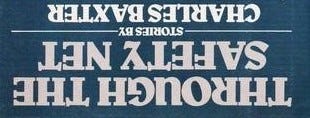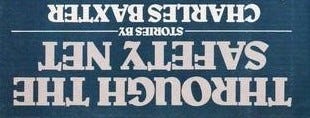Where to start? Let’s start with the tree.
From The Great Gatsby:
“He must have looked up at an unfamiliar sky through frightening leaves and shivered as he found what a grotesque thing a rose is and how raw the sunlight was upon the scarcely created grass.”
At the beginning of the book, the narrator, Nick, is the rose.
‘I love to see you at my table, Nick. You remind me of a — of a rose, an absolute rose. Doesn’t he?’ She turned to Miss Baker for confirmation. ‘An absolute rose?’
By the end, the rose is grotesque, the symbol of how the natural world will always be alien to us. And how we cover that fear of the foreign unknowable by hiding it with language. Sartre used the grotesque tree to stand for all the unknowable life around us. But before him, Fitzgerald had already done this. In the moment before Jay Gatsby is shot to death, he realizes how little he actually knows of existence, and how little control he has over events.
From Through the Safety Net:
“Please don’t go out to the backyard and start chopping down trees.”
And:
“There’s a field, and a tree, and the shape of the tree is disgusting. It’s a disgusting tree, Dinah, I don’t know how else to describe it, gnarled and burnt but with this awful blue fruit still growing on it, like blistered plumes.”
And:
“Beyond the bird she saw their ash tree; something about its shape and color gave her a shock.”
Here’s the classic symbol for the unknowable, a thing we label and pretend to understand and control. It’s death to Gatsby and to Dinah. The morphing tree — first general “trees,” then a disgusting tree similar to the tree in Eden, then a specific “ash” tree (ashes to ashes) — is the perfect morphing object.
Next, consider the pat language.
From Through the Safety Net:
“Dr. Nadler, the dentist, was eating the sole amandine luncheon plate at La Maison Blanc when she was paged.”
Nothing but abstracts. The language, like the characters, are trite and pat and a little smug in their self-assured security. They have enough money to risk gambling on stocks and bonds. When they make a profit they install a swimming pool. Every aspect of their lives is depicted in summarized abstracts: dialing nine for an outside line, doing root canals, being “reachable.”
Dinah Nadler with her tight schedule is a stand-in for Soren Kierkegaard’s Man of Business who smugly makes an appointment, not knowing that a roof tile is about to fall and smash his skull.
From his first sentence, Baxter is building a nice, trite world so he can destroy it. Characters talk in clever tennis match dialog, and Baxter can do this because it’s not supposed to be vital and fresh. It’s supposed to be stale. Just pretty and controlled and unoriginal. Dr. Nadler and her husband drink Liberty School burgundy and need control so badly that they’ve hired a psychic to help them anticipate the future. There’s something of the John Cheever world about Dinah and Jake, a flatness that we’re happy to see wrecked.
Note, it’s lazy, cheap, flat writing full of shortcuts — but only because it’s depicting a banal world whose characters are detached from animal fear.
And we stay with this flatness because…
Baxter makes it funny at first.
Note all the comic buffoonery surrounding the head cold. Classic stage business: nose blowing “a long wet snort,” postnasal drip. A red nose. If not funny, it’s unthreatening. The unlikely character of a psychic investment advisor is grounded in the real-seeming references to money and Consolidated Michigan Edison and Lincoln Tri-State Insurance.
In the beginning the only physical threat is catching a cold. And there’s magic — foretelling the future — but it’s used for the abstract, dreary task of making money. Yet another abstract.
We begin with a lunch and a phone call. We move to a meeting. We have dinner. Another phone call. A late-night snack, interrupted by a phone call. A comforting pattern of eating, talking, eating, talking. Baxter never describes more than a shabby chair and a couple pictures. I’m pointing out the obvious here because I want you to see how stripped down a good story can be. Trite language used to portray smug-but-relatable characters. Limited settings and activities. But building dread, nonetheless.
Note, just the presence of peace creates the threat of chaos. In the story Romance I wrote, “Happiness is like a ticking bomb,” because I’ve always found that peace and happiness automatically create the terror of loss and suffering.
And unlike a dream, this delivery of dire information works because it’s delivered by another person (as opposed to occurring in Dinah’s own dream) and it comes via a system that’s proved its validity by making money. The ultimate validation for us.
Even when the psychic is predicting doom, he describes it in visual terms: a black flame consuming their home, Dinah falling from a trapeze. If anything, Dinah Nadler fails to feel fear, and that forces the reader to carry the building emotion, culminating in…
The long sequence of physical actions…
It begins with:
“That night, as she was putting her daughter to bed, she smelled the air for gas.”
Note, any worry is depicted with an action. Otherwise Baxter tells us how snug and safe the house is. The Corning fiberglass insulation will protect them. And Baxter doesn’t need to be snarky and obvious, here. He just needs to juxtapose the prediction of doom with all the trite abstracts that Dinah and Jake have invested in to keep them safe. Regardless, the seed is planted, the germ transmitted, so the reader expects disaster to occur at any moment. This sequence predates the film Final Destination, but they both use the same dynamic: Prove that disaster is imminent, but don’t explain how it will occur. Then, your audience will expect every ordinary object or action to result in destruction.
Also consider how the tension escalates. First Dinah fears for herself. Then the danger is redirected toward her husband — and don’t we always worry more about our loved ones then we do about ourselves? In fact Dinah never tells Jake that he’s the person in danger. All the while we’re waiting for the paring knife to stab someone, or the water glass to break and cut someone’s throat. Or Dinah to choke on a grapefruit slice. Or the paperboy to be a serial killer. Baxter keeps this sequence of actions going for a glorious page and a half. After all the chatter of dialog — including the most abstract telephone dialog — this long quiet evening at home feels like a lull and an unbearable countdown.
And then there’s the animals…
A bird hits the window and is found crippled and dragging its doomed self in the snow. The dog begins to howl. Two wonderful non-dialog, heart-clutching actions that foretell the apocalypse.
And finally the black-out gesture…
Dinah turns off the light — her abstract, analytical thinking — and leans close to the window to see what’s happening outside. Brilliant.
To me a perfect short story ends at the threshold of a powerful new beginning, for good or bad. This story is seven pages — seven pages! — and it takes us from smug abstraction to visceral horror. And it never dictates where to feel what. There’s never a moment where “Dinah feels a shiver of terror traverse her spine.”1 If anything, she displaces her fear of the psychic’s vision and relocates that fear as distaste for the pictures hung on his wall. And again, if your character feels fear your reader won’t. If your character cries your reader won’t. Baxter forces his readers to have the reactions his characters don’t have. It’s masterful and a powerful lesson.
And in closing…
In writing I’m always trying to reinvent that terror or joy I felt as a child hearing a story. Stories told around campfires in the forest at night were the most frightening, yet they seem like the most difficult to reinvent. I suppose that’s why I love the story Through the Safety Net. It carries the reader from a secure world to a moment of impending horror. The closest I’ve come to that is the story The Prophecy of Ruth that I posted at Halloween.
More often, when I read horror I come across characters who are chilled and shaking and screaming with fright. How ho-hum. Real horror can’t be dictated. Nor can you reason your way to fear. It’s only clear actions and images that accumulate and escalate that truly scare us.
For the next go-round, please look for the story This is Us, Excellent in the collection The Ice at the Bottom of the World by Mark Richard. It’s in print as a paperback, and a book worth having for the rest of your life.
Okay, “gave her a shock” is cheating, but it’s smack at the finish line.








amazon -> through the safety net -> "Customers who bought this item also bought..." (surprise surprise) "... Chuck Palahniuk: The Invention of Sound" and that's it. The customers who bought that item didn't buy anything else.
Thanks for the analysis and also literature tip.
Great. Thanks for this. Also the "if your character feels fear your reader won't. If your character cries your reader won't." insight. Very, very interesting, made me think of the final lines of Amy Hempel's In the cemetery, which had no tears but absolutely broke me. Lots to think about here.